If you’ve ever wondered what some of the first Chicago railfans were like, look no farther than the November 1938 issue of Surface Service magazine, “a monthly publication by and for Chicago Surface Lines employees.” A feature article describes what happened on the very first CSL railfan charter.
1938, of course, was also the year that Central Electric Railfans’ Association was formed, and we expect that most, if not all, of the fans present were early members. As we celebrate our 75th anniversary this year, with a banquet, program, and three special fantrips that you can buy ticketsfor right now, it’s important to remember that we are “standing on the shoulders of giants.”

Surface Service called the fans “Peridromophilists,” among other things, and if you’ve wondered where that strange word came from, it was coined by William James Sidis (1898-1944), a one-time child prodigy who wrote a treatise on collecting streetcar transfers. You can read Notes on the Collection of Transfers here.
Writing this book fueled the public notion that Sidis, as an adult, did not live up to the potential he showed as a youth, where he gained entrance to Harvard at age 11. But many of our best railfans, like Ray DeGroote, started out as transfer collectors.
CERA did not sponsor this excursion, which was run by the Chicago Surface Lines, but gave full support to the venture and counted it as Fantrip No. 5 in our first Annual Report.
We reproduce the entire 1938 article below for your enjoyment:
Peridromophilists Cover System
It’s All Right, Though, for They Are Just Enthusiastic Street Car Fans
Peridromophilists- 69 of them- the most rabidly enthusiastic street car boosters there are- swarmed over the Chicago Surface Lines system October 23 when the first electric railfans’ trip on record opened the properties to the public view.
And though that date is long past, the enthusiasm of the hobbyists is still in evidence as railfans request pictures of the trip, call for further information and plead for additional trips over the world’s largest street car system.
Peridromophily, the more learned writers announce, is the science or art of collecting street car transfers. The less technical, however, do not hold for such narrow limits. Peridromophily covers a wider range, according to the Chicago students of the art. Not only are transfers important but the true student of Peridromophily must know much more about street car types, operating practices, schedules and above all he must have an extensive collection of street car pictures from all over the world.
Street Car Enthusiasts
That’s their story. Boiled down, it all means that the 69 peridromophilists who made the inaugural railfans’ trip over the Surface Lines system are enthusiastic in their preference for street cars. They are all interested in transportation, but they will expound the merits of electric railway transportation above all. And that’s why the Surface Lines was glad to throw open shops and car houses for them on a bleak, cold Sunday afternoon.
A feature writer in the Chicago Daily News wrote a facetious prescription for “catching” a peridromophilist. “The simplest way to catch a peridromophilist,” said he, “is to bait your trap with a picture of No. 209 or maybe No. 9000. No. 209 happens to be the series number of the cable car trailer used by the surface lines of 1872 and No. 9000 the number of the trailer used on the Madison street line around 1921. You can use as bait any of several other numbers- such as 2852, 204, 4001, 7001- all of them representing street cars incorporating distinguishing features.”
Facetious, he was, but there is more than a bit of truth in such a definition. The true railfan such as made up the group on October 23 knows as much or more about the different car types operated by the Surface Lines as do most of the employees. John J. Brown, for example, knows every detail of the cars which have operated in Chicago since the turn of the century. It was Brown who caught the motion picture magnates in an error when they used the wrong type horsecar for scenes in the picture “In Old Chicago.”
Tucker in Charge
Brown was one of the leaders in arranging the trip which was officially conducted over several Surface Lines routes in two Madison street streamliners by James Tucker of the Transportation Department- a peridromophilist in his own right.
The trip was scheduled to start from the Kedzie depot at 12 o’clock noon. Office workers at that station were surprised to see 8 or 10 street car fans on hand an hour and a half early. By noon more than 50 boosters had paid 75 cents for the privilege of taking the trip.
In the Kedzie yards the fans got the first taste of what was in store for them- and by the same token Surface Lines men found out just what enthusiasm would confront them through the afternoon. Spotted for photographers there were such cars as Cook County No. 1, described in the last issue of this magazine, work cars and No. 2858, a rebuilt funeral car.
By 1 P. M. such a crowd was on hand that two Madison street cars were needed to comfortably seat the railfans. Then, with special emblems- “Electric Railfans’ Special”- on either side the trip started amid the cheers of the fans.
The route, one requested by the fans, was south on Kedzie to 47th and east to Lake Park avenue. As the two shining streamliners went south on a clear track, Motormen John Naughton and Marvin J. Clement responded to the pleas of their passengers and turned on the power. By that time speed was an additional thrill but it was neither the first nor the last thrill through a long afternoon. At Lake Park and 55th there was a momentary interruption. Transportation Department officials had ordered that the special cars be given the right-of-way. The passengers of a regularly scheduled car were surprised indeed when they were sidetracked to allow the streamliners to go by.
“That,” said William Hanson, a railfan, “was the greatest thrill I ever had riding a street car.”
Down 47th street and over Lake Park there were few who failed to see the bright, clean streamliners traveling an unfamiliar path. Along every street and particularly at intersections all heads turned and all faces seemed to bear a quizzical “what’s up?” expression.
Switched at 75th
The cars were switched at 75th and then went south on Vincennes, where they were turned in on a 78th street track at the south end of the shops at this location. Photographer Chouinard had to yell his lustiest at that point to halt the headlong dash the fans made for the unusual type cars which had been spotted for them at that point. He managed to halt them just long enough for one group picture and then they scattered at such a rate that the fastest camera lens would have been needed to record their actions.
Only a few minutes passed before the yards were a bedlam of sound. Street car gongs were sounded, mythical fares were recorded and the fans tested air pressure, light switches and almost every testable part of the cars lined up for their inspection.
For the better part of the next hour camera shutters clicked merrily as the fans photographed their favorite models from every angle. It was then that Photographer Chouinard was able to snap the out-of-town fans who had come from such distant points as Kankakee, Illinois, South Bend and Elkhart, Indiana, St. Joseph, Michigan and other points. Some of the fans who traveled the greatest distances are shown on the back cover of this issue.
Tour South Shops
Then when all the fans had snapped numerous pictures- though hindered by lack of sun and the coldest weather of the season- the group was escorted through the
South Shops by Superintendent C. D. Mack and several of his assistants. This, for the great majority, was the climax of a great day. Many of the most ardent fans were familiar with most of the rolling stock but few, if any, had ever been within the shop doors.
Many of the shop’s most interesting machines were described by Mr. Mack and almost every statement drew further questions. Similarly, when the group moved into the paint shop some of the older model cars there invoked technical discussions as to the merit of this model or that. In the long run, however, everybody was satisfied and the group boarded the cars for the run back to Kedzie depot.
The railfans- or peridromophilists if you will- had the time of their lives and they may have a warm spot for the Surface Lines in their hearts following their excursion over the system. Their letters proved it!
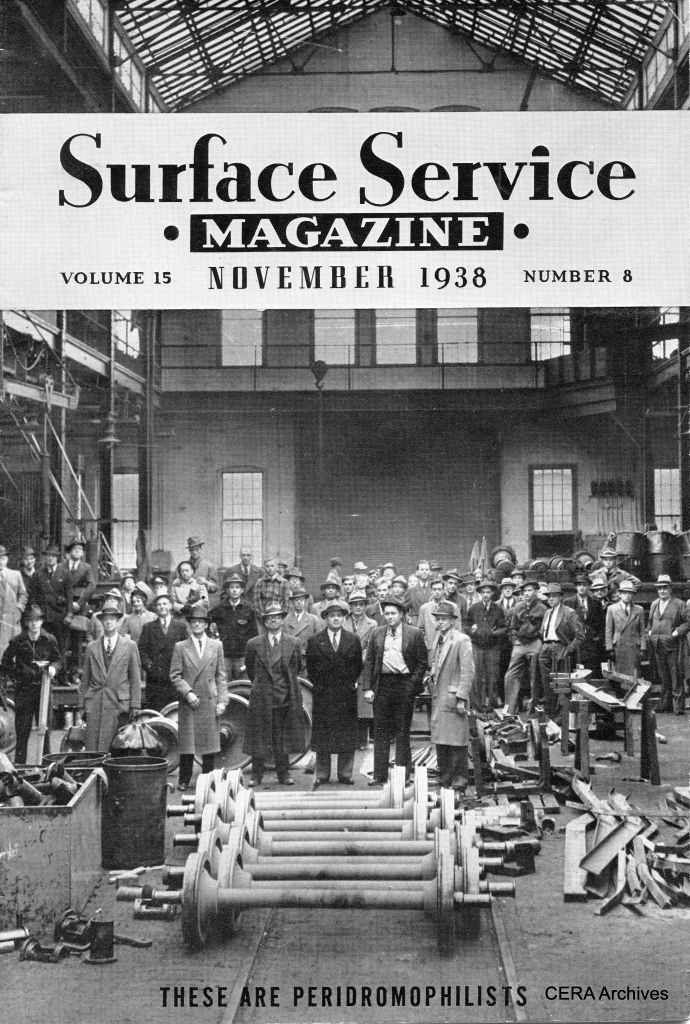
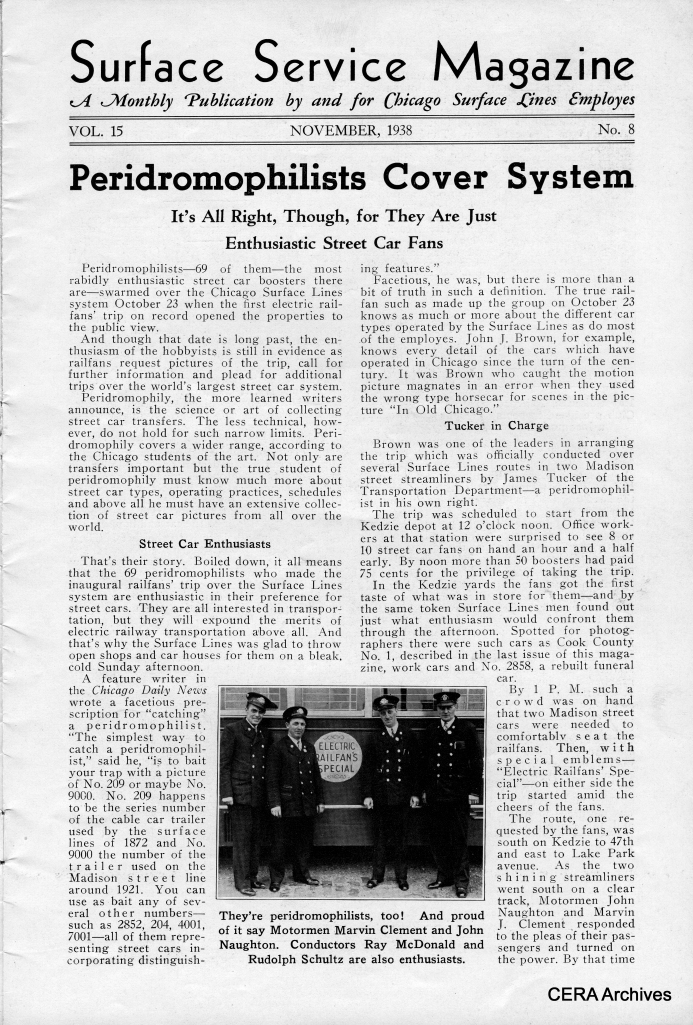
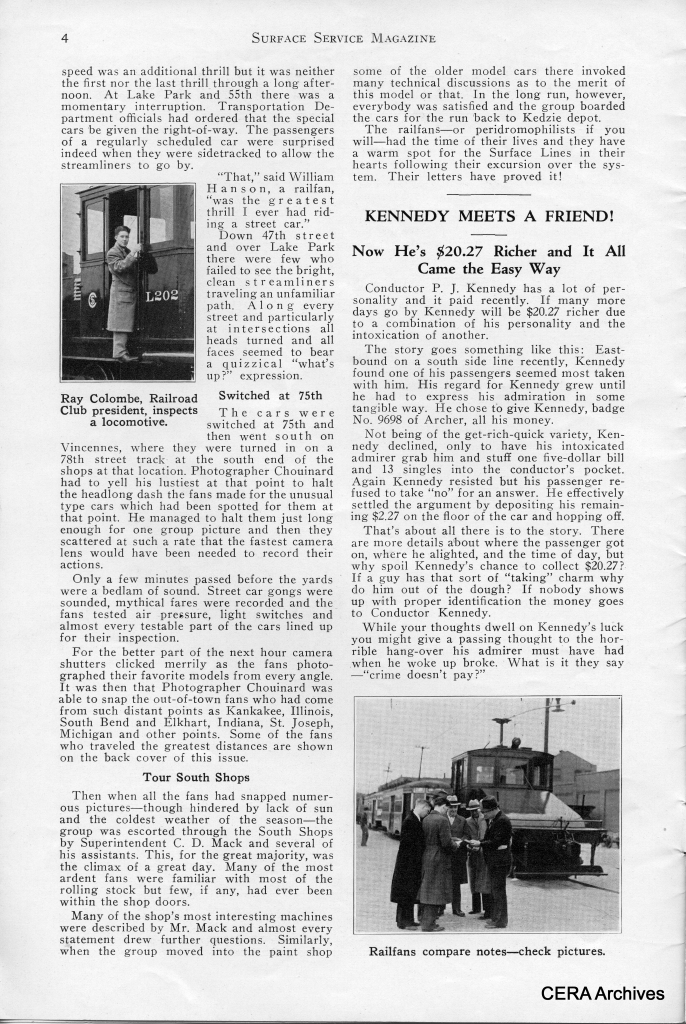
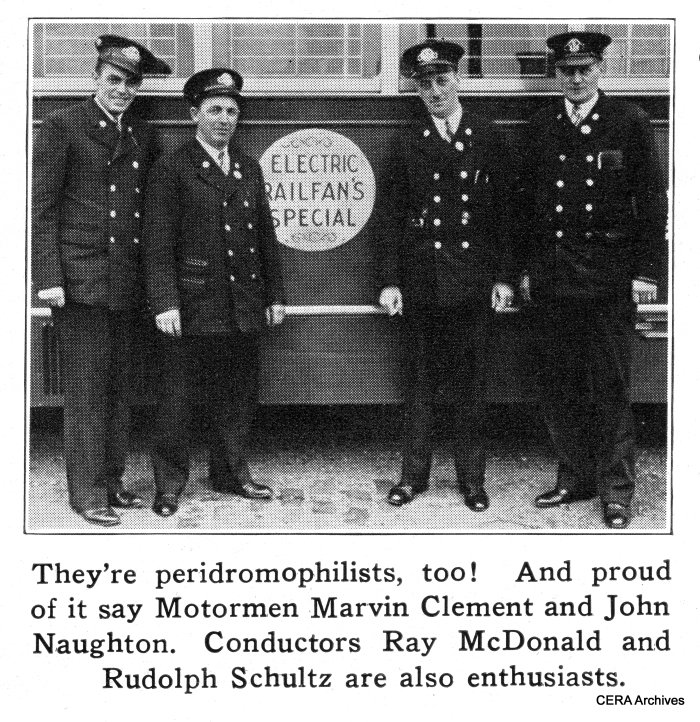
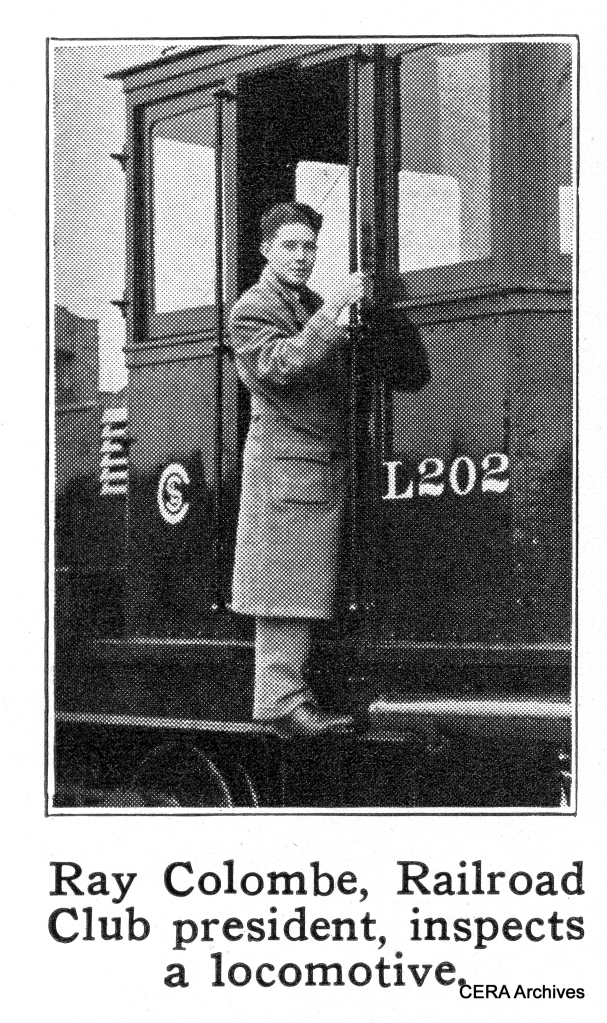
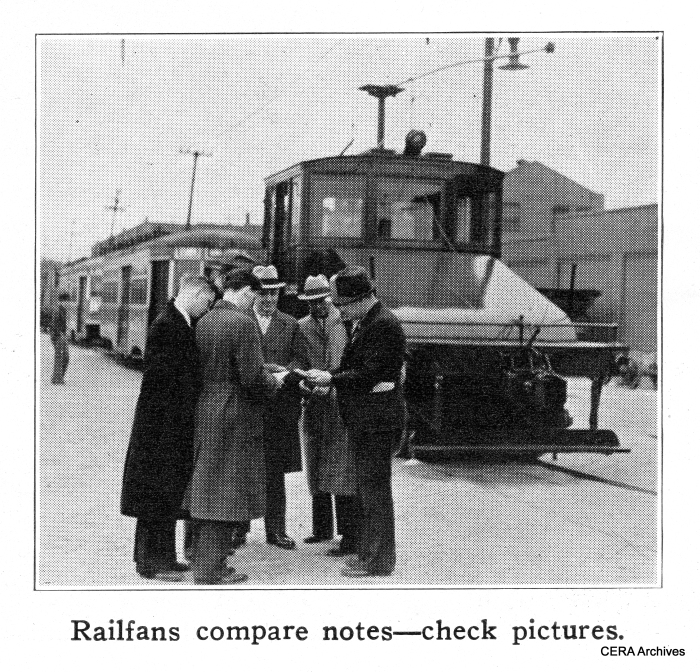
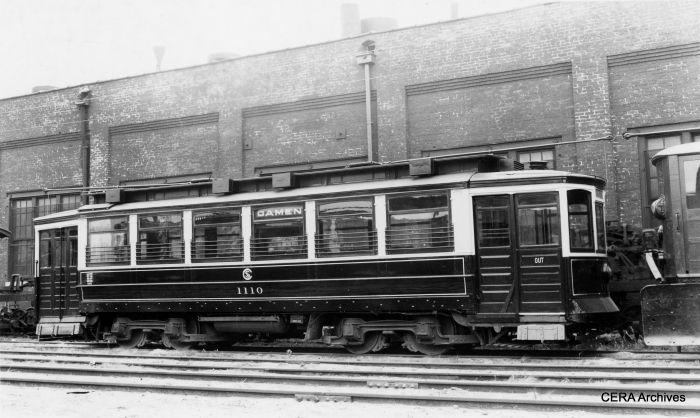
CSL 1110 as it looked on October 23, 1938. (Photo by Lamar M. Kelley)
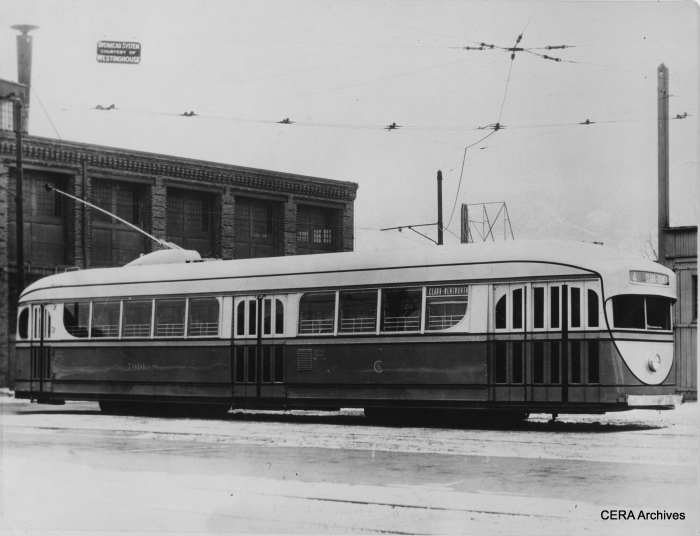
CSL Pre-PCC 7001, shown as it entered service in 1934, was one of the cars inspected by the railfans. Sometimes, it’s funny how some cars got saved and others did not. The empty shell of 4001 was saved because it was thought the windows were at the right height to make a good hot dog stand. Meanwhile, this car, although complete except for the seats, was not saved. The windows were too high to make a good hot dog stand.
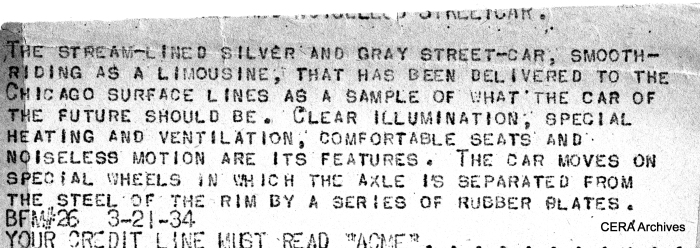
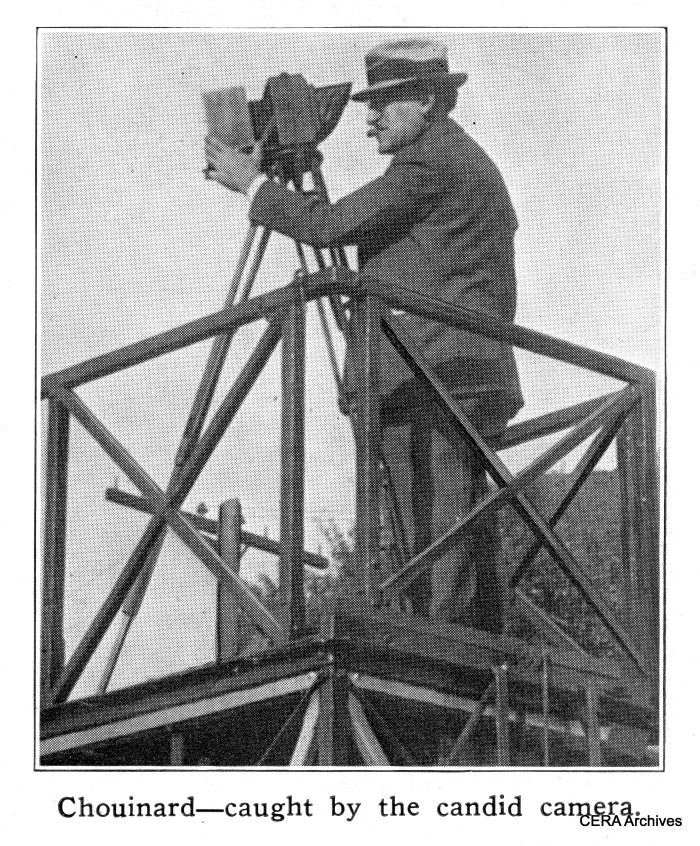
MEET YOUR PHOTOGRAPHER!
Here’s Miniature ‘Photo’ of the Man Who Makes the Best
The railfan photographs which decorate the front and back cover of this magazine were taken on a cold and murky day when the absence of light reminded A. R. Chouinard of the early days when it wasn’t uncommon to have to expose plates from five minutes to a half-hour. That’s another way of saying that Fred- few know him as Alfred R.- knows his business from the ground up.
Fred came to the Surface Lines in 1927 and his work is primarily concerned with photographing accident cases. It is his sideline work that makes him a most valuable addition to the Surface Service Magazine staff. He is the man who is always on the job for bus openings, baseball games and other employee activities and his skilled camera hands have returned many notable pictures to the magazine editors. He is, in many ways, an unsung mainstay of the magazine, for without his pictures it would be very dull indeed.
Mrs. Disney’s boy, Walter, out there in Hollywood, has affection and regard fro Fred, too. Disney first learned the art of photographing from Fred back in the days when animated films were used for advertising and filled in motion picture programs while the operator changed the reels between shows.
We’re particularly proud of Chouinard’s picture which accompanies this sketch. He didn’t know it was taken and it will be a surprise to him. It’s very typical- there’s Fred atop a tower wagon with his ever-present stub of a cigar and his trusty camera ready for action.
Many of Chouinard’s pictures have received high praise at various photographic exhibits, but the pictures which decorate his office are the pictures of the men with whom he works. That is another slant on the kind of a friend Fred Chouinard is.
Editor’s Note- CSL photographer Alfred R. Chouinard was born in 1879 and died in 1967. The body shell of CSL experimental pre-PCC streetcar 4001 is at the Illinois Railway Museum in Union. So is Chicago cable car trailer 209. According to cable car historian Joe Thompson, this is a “1934 replica with some original parts.”
-David Sadowski